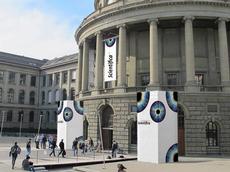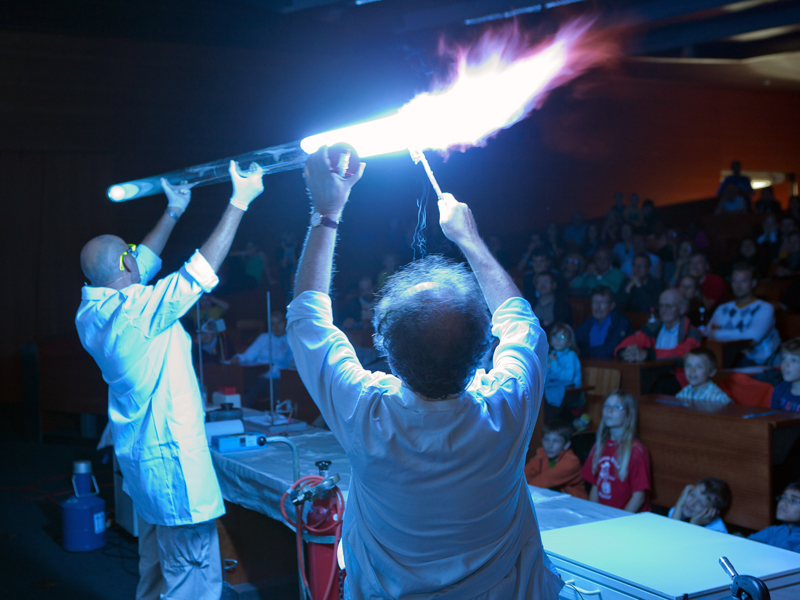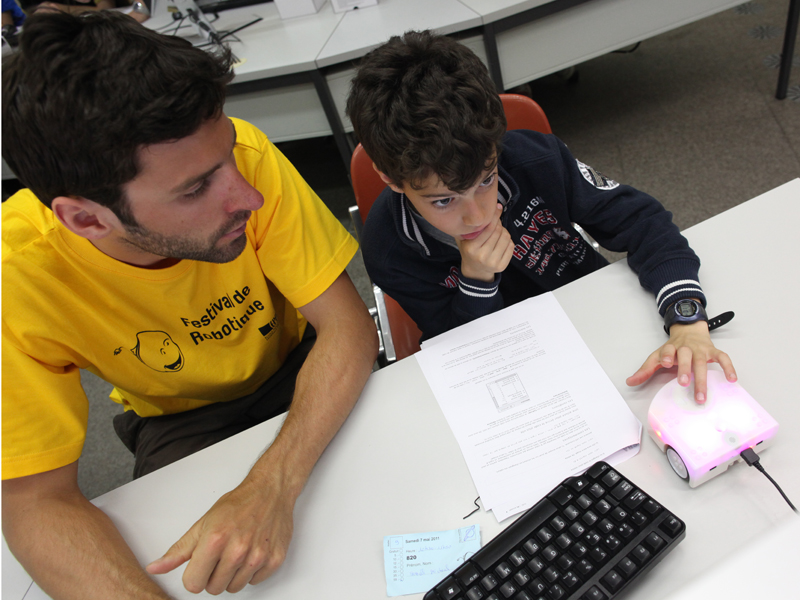Cutting-edge research is child’s play
Children can programme a robot. Boys and girls can enjoy a thrilling adventure while supplying a virtual world with energy. Old and young people alike can make a model of the human genome. “Scientifica” will excite the whole family. ETH Life is raffling 5 x 2 tickets for the opening event “Money and the mind – the fuels of society”.

Energy is a subject that affects everyone, from cutting-edge research to industry, politics and society. “Scientifica” is a forum in which ETH Zurich and the University of Zurich can exchange their knowledge with the public: from 26 to 28 August 2011 – in the Main Hall of ETH Zurich, in the University’s Lichthof and in the “Scientifica Tent” on the Polyterrasse – researchers and university staff will be presenting their latest projects on the theme of energy for the mind, body and everyday life. At the same time, they will be giving impressive demonstrations to show that even sophisticated scientific models are as easy as child’s play to understand.
Children programming robots
The Robot Workshop, for example, which takes place on the University of Zurich premises on Sunday, is an exciting event for 8- to 16-year-olds: its centrepiece is “Thymio II”, an educational robot developed by Stéphane Magnenat, a scientist at the Autonomous Systems Lab (ASL) of ETH Zurich, and researchers at EPFL.
“Thymio II”, with its white, box-shaped design, appears quite unremarkable at first glance. Yet the mini-robot has a lot to offer: it navigates its way through the room, carefully considering its route. If it encounters an obstacle, it briefly lights up red and blue and steers away from it. Its colours have meaning: for example, if it glows green , it is exhibiting friendly behaviour, while red suggests it is anxious and violet means it is being obedient! But “Thymio II” can do even more: if it placed on a ball, it balances so skilfully that it is never in any danger of falling off. “Thymio fascinates children because it is so mobile and constantly changes colour. It is also very suitable for physics experiments and as a component for cablecars or tracked vehicles”, says Stéphane Magnenat.
Computer game: energy research can be fun
“MINT Land” is also fascinating: this computer game invites 10- to 13-year-olds on a voyage of discovery through the world of mathematics, computer science, natural sciences and engineering. “The game should simply be fun”, says Monika Keller Seitz, who co-developed the game as Project Manager at the Office of Equal Opportunities for Women and Men at ETH Zurich. She was assisted by, among others, laser physicists and quantum scientists. “In ‘MINT-Land’ boys and especially girls learn that energy research examines some really ‘cool’ topics”, Keller Seitz explains.
To move around in “MINT Land”, players can choose a girl, a boy or a robot as their avatar. Then they must solve various tasks in a virtual island world. For this they receive “energy stars” as a reward. They need these stars because every luxury or effort costs extra energy, even in the virtual world. The players obtain energy by winning games of skill, with each game exploring a topic relating to energy research. In “Electron racing”, the players dash through a power line. To increase their speed, they must collect gold. They receive a deduction if they collect diamonds instead, and they become slower. This teaches the children that gold – in contrast to diamond – is a good conductor. Visitors to “Scientifica” can test out the first version of the game in the University’s Lichthof.
Building and understanding genetic material
A team led by molecular biologist and brain researcher Isabelle Mansuy has developed a simple DNA model made of paper, which visitors to “Scientifica” in the ETH Zurich Main Hall can assemble themselves and take away with them. In the Neuroscience Center at the University of Zurich, Irchel Campus, the double professor at ETH Zurich and the University researches how environmental factors influence learning processes at the molecular level.
As they build the DNA model, the visitors learn how the human genome is constructed in cell nuclei and how certain proteins (histones) can activate or block genes depending on the nature of the environmental effects. For example, this mechanism ensures that mice living in varied surroundings still have a great ability to learn even when they reach old age.
At ETH Zurich there is also a chemistry show for children and young persons, with plenty of sparks and bangs, and the “Scientifica Slam Trophy”, in which young scientists and students compete to win the public’s favour.
“Scientifica – Zurich Research Days”
Exhibition opening
times
Fri. 26 August: 17:00–22:00
Sat. 27 August: 13:00–20:00Sun.
28 August: 11:00–16:00
Venue
ETH Zurich Main Hall, Zurich University Lichthof and Foyer
Raffle
ETH Life is raffling 5 x 2 tickets for the opening event “Money and the mind
– the fuels of society” with
a panel discussion and a welcome speech
by City Councillor André Odermatt, Director of the Building and Construction
Department of the City of Zurich.
To take part in the raffle, send an e-mail with the subject
“Scientifica11 - Eröffnung” to redaktion@ethlife.ethz.ch. The deadline for
entries is Wednesday, 24 August 2011, 12:00 hrs.
Information
about the projects being presented
The “Programming robots” workshop takes place on
Sunday 28 August 2011 at 11:00, 13:00 and 14:30 hrs respectively in Room D11 at
the University of Zurich.
The programmed “Thymio II” mini-robot can be bought
for CHF 60 instead of CHF 99.
The “MINT Land” computer game can be played at
Stand A12 “Who are the researchers of the future?” in the University of Zurich Lichthof.
Neuroscientist Isabelle Mansuy’s DNA model will be presented at Stand G02 “Why are we motivated
to acquire new knowledge?” in the
ETH Zurich Main Hall.
Free
tickets for events
Due to the limited number of places, visitors to “Scientifica” need admission tickets for the
short lectures, special events, the children’s lectures and the “Programming robots” workshop. The free tickets can be collected on the day of the event at the information stands in the
University Lichthof and at the main entrance of ETH Zurich.











READER COMMENTS